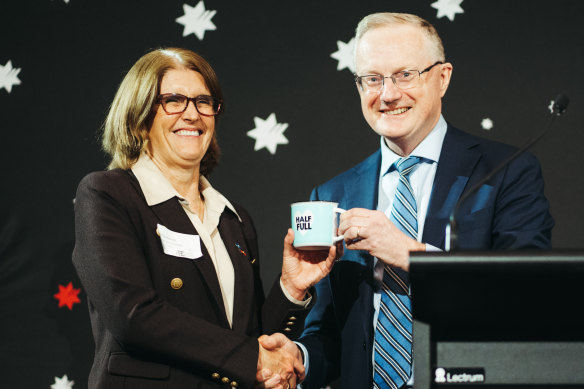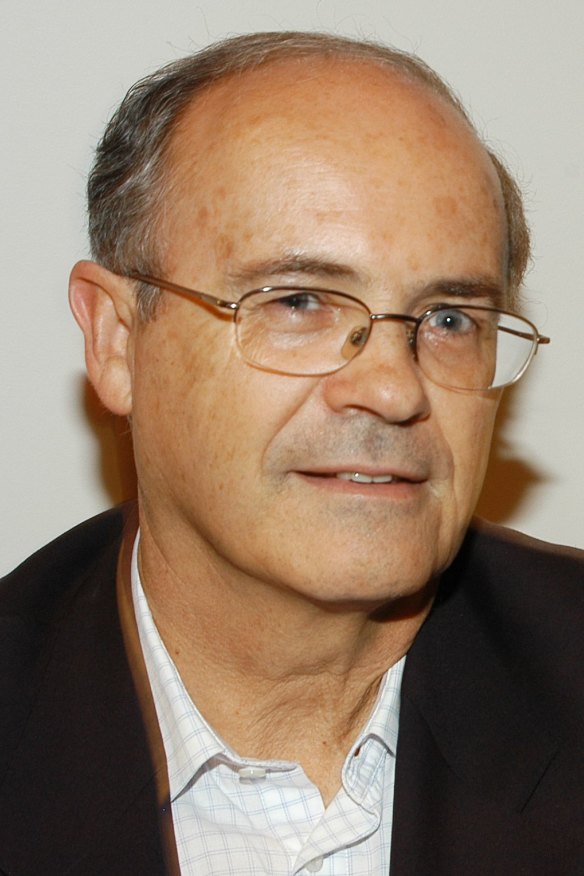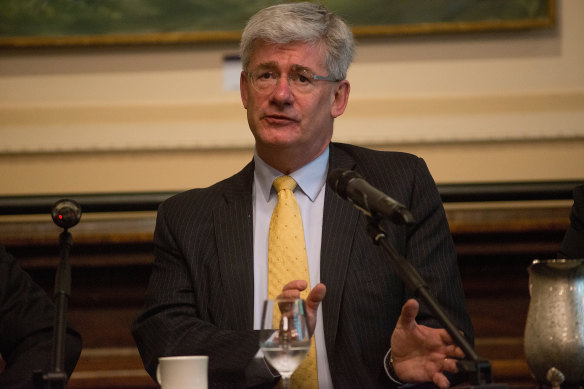By Shane Wright
Save articles for later
Add articles to your saved list and come back to them any time.
When Philip Lowe took on the job of Reserve Bank governor seven years ago, his predecessor left him a gift.
Glenn Stevens, who had helmed the bank for a decade including through the global financial crisis, gave Lowe a coffee mug emblazoned with “half full” on the side.
The glass half-full mantra has guided Lowe, a self-described optimist about the Australian economy, through the many ups and downs of his tenure, which ends next Friday.
Reserve Bank governor Philip Lowe hands his successor, Michele Bullock, his optimistic coffee mug.Credit: Dion Georgopoulas
When Lowe started in 2016, official interest rates had just been sliced to a fresh record low of 1.5 per cent. Inflation, which the RBA seeks to keep within a 2 and 3 per cent band, was at 1.3 per cent while the jobless rate was 5.7 per cent.
He ends with inflation around 6 per cent, unemployment at 3.7 per cent – the lowest level since the 1970s – and the cash rate at 4.1 per cent.
In between, the bank under Lowe has gone through a pre-COVID period of inflation running too low, the pandemic era of huge central bank stimulus through quantitative easing, and more recently the most aggressive tightening of monetary policy in three decades to deal with high inflation.
But, as Lowe conceded in his final public address this week, what he may be best remembered for is his commentary about the timing of interest rate movements, for which he later apologised.
As late as November 2021, he was telling home buyers and business owners that official interest rates, at that point still 0.1 per cent, were unlikely to rise until 2024.
By May 2022, and in the midst of the federal election campaign, the RBA had blinked. Rates would climb and climb and climb.
To his defenders, Lowe faced the toughest set of economic circumstances in almost a century and delivered the lowest unemployment in 50 years. Inflation is high, but it is easing without the bank causing a recession.
Selwyn Cornish, the Reserve Bank’s official historian, says no governor since Sir Ernest Riddle, who ran the central bank during the 1930s Great Depression, faced anything like the events that confronted Lowe, whom he describes as a person of great integrity.
“Phil Lowe’s tenure is really dominated by COVID. It’s the first pandemic since the end of World War I, 100 years ago,” he said.
“I think you would have to go back to the Great Depression for a bigger challenge to have been confronted by the Reserve Bank.”
Cornish says Lowe’s immediate predecessors in Stevens, Ian Macfarlane and Bernie Fraser, all faced substantial challenges. But nothing of the level that Lowe confronted.
He said the criticisms of Lowe ignored the very nature of the job.
The Reserve Bank’s official historian, Selwyn Cornish, says Lowe faced the toughest circumstances of any central bank governor since the Great Depression.Credit: Nine News
“You can’t please everyone. You know you’re making decisions that will upset people, hurt people, but you have to make that decision for the entire economy,” Cornish says.
But Lowe’s critics are much more hard-headed.
Independent economist and long-time RBA watcher Saul Eslake says that going by the Reserve Bank’s own stated role, Lowe has fallen short.
That role, keeping inflation between 2 and 3 per cent, is the RBA’s guiding star.
“Both Lowe’s predecessors, Ian Macfarlane and Glenn Stevens, had inflation in the middle of the Reserve Bank’s target band during their terms. They had their terms extended out to 10 years,” he says.
“In the first four years of Lowe’s term, inflation was under the target band. And it’s ending with inflation well above the bank’s target band.
Independent economist Saul Eslake says under Lowe’s tenure, the RBA failed to hit its inflation target.Credit: Jesse Marlow
“Fairly or otherwise, he will be remembered as the Reserve Bank governor who didn’t hit the inflation target during his term.”
Lowe said this week that during his tenure, inflation had averaged 3 per cent. He failed to mention that inflation was within the target band just nine of the 84 months he ran the bank.
Eslake says every central bank in the world has struggled with the surge of inflation of the past 18 months.
But unlike overseas counterparts such as America’s Jerome Powell and the European Union’s Christine Lagarde, Lowe had told Australians not to expect an interest rate rise until 2024.
“Every central bank in the developed world made the same mistake of keeping interest rates too low for too long. But the unique mistake of Phil Lowe was to put a date on it,” he says.
This year’s independent review of the Reserve Bank – the first of the institution since the early 1980s – highlighted issues with the bank’s handling of key economic issues ahead of, during and after COVID-19, and found problems with the bank’s communication processes while recommending changes to improve its overall culture.
Westpac chief economist Bill Evans, however, noted this week that Lowe had elevated the public economic debate during his time.
Lowe has used more than 150 speeches, public presentations and appearances before various committees to touch on a range of issues. They have included his long-running calls for reforms to boost productivity, worries about the nation’s housing policies and even the level of JobSeeker.
According to Evans, Lowe’s legacy will endure.
“I think your greatest legacy has been the way you interpreted the economic conditions, the policy debate and people at our level … have learned so much. The public have learned so much,” he told Lowe at his final public address.
The public, especially those paying a mortgage, may harbour different views. National accounts data released this week showed home buyers paid a record $24.5 billion in interest in the June quarter thanks to the surge in interest rates.
In the past year, the interest bill alone has reached $83 billion, double what it was for the previous 12 months.
That bill, plus the sharp increase in rents being paid by a third of the population, means consumer spending is cratering.
That interest bill is closely related to one of the many issues Lowe raised in his first public appearance as governor, before the House of Representatives’ economics committee in September 2016.
“I think it would be good for us all if the cost of our housing relative to our income were a bit lower,” he noted.
Seven years on, this week he pushed back at suggestions it was the Reserve Bank’s low interest rates to blame for the nation’s expensive housing. It was, he said, due to our collective choices – from where we live, how our councils zone land and the tax system, to how we design our cities.
“In each of these areas, our society and politicians have made choices that lead to high urban land and housing costs. It is by tackling these issues that we can address the high cost of housing in Australia, which I view as a serious economic and social problem,” he said.
Towards the end of his speech on Thursday, Lowe held aloft the half-full coffee mug left to him by Stevens, and handed it to Michele Bullock, who on September 18 will become the first woman to head the Reserve Bank.
“I do so in the hope that as you navigate the uncertainties ahead, you will remember that that glass is indeed half full and that we have a lot to be fortunate about here in Australia,” he said.
Cut through the noise of federal politics with news, views and expert analysis. Subscribers can sign up to our weekly Inside Politics newsletter here.
Most Viewed in Politics
Source: Read Full Article


